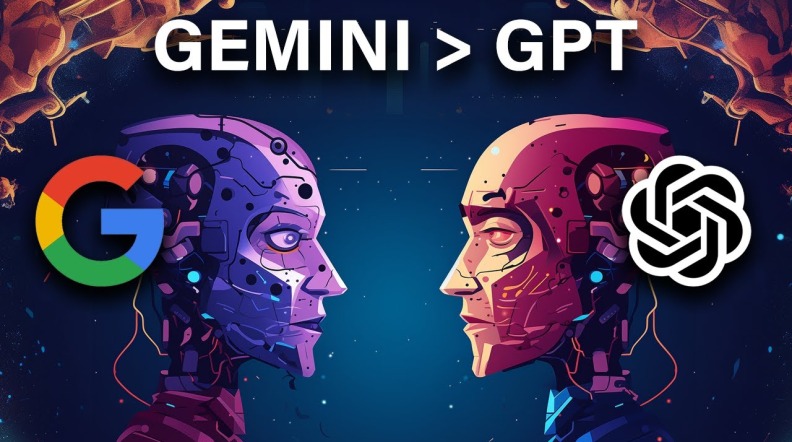Google Gemini vs OpenAI: Unveiling the Future of AI Chatbots






The world of artificial intelligence is witnessing a monumental shift with the advent of Google Gemini and OpenAI’s ChatGPT. These two giants are not just changing the landscape; they’re setting the stage for an unprecedented era of AI chatbots. As they evolve, the question arises: which one will lead the future of AI?
Google Gemini and OpenAI have both introduced groundbreaking technologies that push the boundaries of natural language processing and understanding. They offer unique approaches to interaction, learning, and problem-solving, making them frontrunners in the AI race. Yet, their differences are as pronounced as their innovations, sparking debates on efficiency, creativity, and ethical considerations.
Comparing Google Gemini and OpenAI’s ChatGPT reveals the depth and diversity of AI advancements. From their foundational technologies to their practical applications and ethical frameworks, each offers insights into the future of AI chatbots. As this comparison unfolds, it becomes apparent that the journey toward AI excellence is both collaborative and competitive, with each entity contributing to the broader narrative of artificial intelligence.
Introduction to the Titans of AI: Google Gemini and OpenAI ChatGPT
Google Gemini and OpenAI’s ChatGPT stand as titans in the realm of artificial intelligence, each backed by powerful core technologies and a vision for the future. Google’s Gemini project, with its Gemini nano and focus on mobile devices, is redefining what AI can do on the go. OpenAI’s ChatGPT, with its advanced natural language processing capabilities, challenges the limits of machine-human interaction. Together, they showcase the dynamic range of AI’s potential, from multimodal capabilities to seamless integration across platforms.
The Genesis of Google Gemini and ChatGPT
The origins of Google Gemini and OpenAI’s ChatGPT trace back to a shared ambition to revolutionize AI’s role in our daily lives. Gemini nano and the emphasis on making AI accessible through mobile devices reflect Google’s approach to ubiquitous computing. OpenAI, meanwhile, focused on harnessing multimodal capabilities to create ChatGPT, an AI that can understand and generate human-like text. This convergence of aims has set the stage for an AI evolution, where accessibility and capability go hand in hand.
Core Technologies Behind Gemini and ChatGPT
At the heart of Google Gemini and OpenAI’s ChatGPT lie their core technologies, which are pushing the frontiers of what AI can achieve. Google Gemini leverages cutting-edge advancements to enhance mobile computing, while OpenAI has developed ChatGPT to mimic human conversation accurately. These foundational technologies not only define their capabilities but also their potential to transform industries, making AI more integrated into everyday tasks and interactions.
In-Depth Comparison: Gemini vs ChatGPT
When comparing Google Gemini and OpenAI’s ChatGPT, several factors come into play. Google Gemini’s access to GPT-3 and GPT-4 turbo through API access allows for a range of functionalities in multiple languages, while Google charges for advanced features in Gemini Pro. On the other hand, ChatGPT’s integration of these technologies enables users to experience AI-driven interactions across various platforms, highlighting the importance of accessibility and versatility in today’s AI market.
Natural Language Understanding and Processing
The battle between ChatGPT and Gemini in natural language understanding and processing is a close one. Both are adept at reading comprehension and tasks like summarization, but they are primarily limited to text. This focus on text-based interaction showcases their strengths in handling complex conversations and providing accurate responses to user queries.
Language Models and Their Capabilities
The capabilities of language models like GPT-3 and GPT-4 turbo are at the forefront of the competition between Google Gemini and OpenAI’s ChatGPT. These models empower the AI to understand and generate human-like text, making interactions more natural. Their ability to process a vast array of information and mimic human conversation patterns is what sets them apart in the realm of AI chatbots.
Ethical Reasoning and Decision-Making in AI
In the realm of ethical reasoning and decision-making, both AI models, including Claude 2 and Mixtral model, are put to the test. The comparison of ChatGPT and Gemini in how they handle ethical queries reveals a commitment to responsible AI development. These models are designed to navigate the complexities of ethical dilemmas, ensuring AI’s decisions align with human values.
How Gemini and ChatGPT Tackle Ethical Queries
Google Gemini and OpenAI’s ChatGPT tackle ethical queries by integrating advanced AI models that prioritize ethical reasoning. Through careful programming and design, they aim to make decisions that reflect human ethical standards. This approach to ethical queries is crucial in building trust and ensuring AI is used responsibly across various scenarios.
Creative Text Generation: Pushing the Boundaries
The arena of creative text generation is another field where Google Gemini and OpenAI’s ChatGPT showcase their prowess. Both AI chatbots push the boundaries of creativity, generating text that is not only coherent but also innovative. This capability opens up new possibilities for content creation, storytelling, and more, highlighting the creative potential of AI.
Comparing Creative Flair and Adaptability
When comparing the creative flair and adaptability of Google Gemini and OpenAI’s ChatGPT, it’s evident that both bring unique strengths to the table. Gemini’s ability to tailor content for mobile devices and ChatGPT’s versatile language models both showcase how AI can adapt to meet user needs. Their creativity is not just in generating text but in how they can personalize and enhance user experiences.
User Experience Showdown: Google Gemini vs ChatGPT
The user experience offered by Google Gemini and OpenAI’s ChatGPT is a critical aspect of their comparison. Both aim to provide seamless interactions, but their approaches differ. ChatGPT users, for instance, have praised its intuitive interface and the naturalness of its conversations. Gemini’s focus on mobile devices means it too is designed with user experience at the core, ensuring accessibility and ease of use are prioritized.
Interface Design and Ease of Use
The interface design and ease of use are where Google Gemini and OpenAI’s ChatGPT particularly stand out. Both have developed user-friendly interfaces that cater to a broad audience. The emphasis is on minimizing complexity and making AI interactions as straightforward as possible, ensuring users of all skill levels can navigate and utilize these chatbots effectively.
Customization Features and User Preferences
Customization features play a significant role in enhancing user preferences for both Google Gemini and OpenAI’s ChatGPT. The ability to adjust settings, personalize interactions, and tailor the AI’s responses to fit individual needs marks a significant advancement in AI chatbot technology. This level of customization ensures a more personal and engaging user experience, setting a new standard for AI interactions.
Response Time and Efficiency
Response time and efficiency are crucial metrics for comparing Google Gemini and OpenAI’s ChatGPT. Both chatbots strive to provide swift and accurate responses to user queries, minimizing wait times and maximizing productivity. Their performance in this area is a testament to the advanced technologies powering these AI systems, highlighting their potential to revolutionize real-time communication and assistance.
Advanced Features: Gemini Pro and ChatGPT Plus
When exploring the landscape of AI-driven chatbots, advanced features set Gemini Pro and ChatGPT Plus apart. Both platforms offer enhanced capabilities, catering to more demanding tasks and complex requirements. From deeper coding assistance to sophisticated image generation, these versions promise a leap in AI interaction. They cater to users seeking more than just conversational support, aiming to provide tools that significantly ease and innovate the development process and creative projects.
Beyond Basic Coding: Advanced Developer Assistance
Gemini Pro and ChatGPT Plus elevate the coding experience by offering robust developer support. This goes beyond simple code suggestions, encompassing debugging help, code optimization, and even the generation of complex code snippets. Such advanced features are invaluable for developers looking to streamline their workflow and enhance productivity. It signifies a move towards an AI partnership where routine tasks are efficiently managed, allowing human creativity to focus on more challenging aspects of development.
Translational Abilities and Cultural Awareness
Both platforms exhibit remarkable translational abilities coupled with a deep understanding of cultural nuances. This feature is crucial for global businesses and users who interact with diverse cultures. By accurately translating and interpreting cultural contexts, Gemini Pro and ChatGPT Plus bridge communication gaps, making them powerful tools for international collaboration and global market penetration.
Cross-Lingual Understanding in AI Chatbots
The AI models powering Gemini Pro and ChatGPT Plus excel in cross-lingual understanding, a testament to their advanced NLP capabilities. Leveraging Google AI Studio’s technological prowess, these chatbots can comprehend and respond to queries in multiple languages with impressive accuracy. This feature is instrumental in providing seamless service to users worldwide, showcasing the global reach and adaptability of modern AI chatbots.
Vision Model Comparison: Image Generation Capabilities
Image generation capabilities distinguish Gemini Pro and ChatGPT Plus, leveraging Google AI Studio’s advanced vision models. These features enable the creation of detailed, contextually relevant images from textual descriptions, opening new avenues for creative and marketing endeavors. Such capabilities demonstrate the evolving versatility of AI chatbots, extending their utility beyond text-based interactions.
From Art Creation to Hyperrealistic Imagery
The artistic and hyperrealistic imagery capabilities of Gemini Advanced and ChatGPT push the boundaries of AI creativity. Users can generate art pieces or realistic images based on detailed prompts, facilitating a range of applications from digital art creation to marketing material development. This feature exemplifies the merging of technology and creativity, offering new tools for artists and professionals alike.
Practical Applications and Real-World Testing
In real-world applications, the versatility of Gemini Advanced and ChatGPT is put to the test. From organizing trips to solving complex problems, these AI chatbots demonstrate a remarkable ability to understand and assist with a wide range of tasks. Their ability to provide relevant, context-aware solutions in real-time makes them invaluable assistants in both personal and professional settings, showcasing the practical impact of AI on daily life.
Scenario-Based Testing: From Trip Planning to Problem-Solving
Through scenario-based testing, the practical efficacy of the latest version of Gemini and Gemini Advanced and ChatGPT is evaluated. These tests span various domains, including trip planning and complex problem-solving, highlighting the chatbots’ adaptability and intelligence. Such real-world testing underscores the chatbots’ potential to streamline tasks, improve decision-making, and enhance user experiences across diverse scenarios.
Educational Uses: Simplifying Complex Concepts
Within the educational domain, Gemini offered alongside ChatGPT plays a pivotal role in simplifying complex concepts for learners. By providing clear, concise explanations and engaging interactive learning experiences, these AI tools facilitate a deeper understanding of challenging subjects. This application not only enhances educational outcomes but also makes learning more accessible and enjoyable for students of all ages.
Professional Assistance: Brainstorming and Planning
The advanced capabilities of Gemini offered in the professional realm significantly aid in brainstorming and strategic planning. By offering fresh perspectives and generating innovative ideas, these AI chatbots become invaluable tools for professionals seeking to push the boundaries of creativity and strategy. Their input can lead to more effective planning sessions and creative solutions to business challenges, marking a new era of AI-assisted professional development.
The Price of Innovation: A Pricing Comparison
When comparing the pricing models of Gemini Pro 1 and GPT-4 Turbo, it’s evident that innovation comes at a cost. Both platforms offer tiered pricing structures, with Gemini Pro 1 and GPT-4 Turbo allowing users to scale their usage based on needs. The initial allocation of 1k tokens for output underlines the platforms’ commitment to providing value for money, ensuring that users only pay for the computational resources they consume.
Subscription Models and Access Tiers
The subscription models and access tiers for Gemini Pro 1 and GPT-4 Turbo cater to a wide range of users, from individuals to large enterprises. These models are designed to be flexible, accommodating the varying needs of users with different demands and budgets. By offering multiple tiers, both platforms ensure that users can access advanced AI capabilities without overspending, making cutting-edge technology accessible to a broader audience.
Assessing Value for Money
In assessing the value for money offered by Gemini Pro 1 and GPT-4 Turbo, it’s crucial to consider the balance between cost and capabilities. The platforms’ advanced features, such as enhanced coding assistance and image generation, provide significant value to users seeking more than basic AI interactions. This evaluation highlights the importance of choosing a platform that aligns with specific needs and goals, ensuring that the investment in AI technology yields tangible benefits.
The Future Is Now: Gemini and ChatGPT in Everyday Life
The integration of Gemini and ChatGPT into everyday life marks a significant milestone in the evolution of AI. These chatbots offer a wide range of functionalities, from simplifying daily tasks to providing professional assistance, demonstrating the practical benefits of AI technology. Their presence in homes and workplaces underscores the transformative potential of AI, making advanced technology an accessible and valuable tool for people around the world.
Home Assistance and Everyday Queries
For home assistance and managing everyday queries, Gemini and ChatGPT stand out as versatile and reliable AI companions. Whether it’s scheduling appointments, providing weather updates, or offering educational support, these chatbots deliver timely and accurate information, enhancing the efficiency and convenience of daily routines. Their adaptability and ease of use make them indispensable tools in the modern household, showcasing the practical applications of AI in improving everyday life.
Helping Professionals and Businesses
Google Gemini and OpenAI’s ChatGPT are transforming how professionals and businesses operate. With Gemini Pro’s advanced AI capabilities, companies can automate complex tasks, enhancing productivity. Similarly, ChatGPT helps businesses streamline customer service through its intuitive chat interfaces. Both AI chatbots offer tools for generating reports, scheduling, and even marketing strategies, making them invaluable assets for any professional seeking efficiency and innovation.
Navigating the Challenges: Hallucinations and Misinformation
As AI technology advances, so do the challenges of hallucinations and misinformation. Both Google Gemini and OpenAI’s ChatGPT face these issues, where the AI might generate incorrect or misleading information. Addressing these concerns involves prompt engineering, where the way questions are asked is carefully designed to reduce errors. Moreover, developers continuously update the models with accurate information and corrections, ensuring the AI learns from its mistakes and improves over time.
Addressing AI Missteps and Corrective Measures
In the realm of AI, missteps such as generating incorrect information or failing to understand context are inevitable. To combat these issues, Google Gemini and OpenAI’s ChatGPT rely on robust systems for feedback and corrections. This involves users flagging incorrect responses, which are then reviewed and used to refine the AI’s algorithms. Through such corrective measures, both platforms strive to minimize errors and enhance the reliability of their responses.
Continuous Learning and Model Improvements
Continuous learning is at the heart of improving AI chatbots like Google Gemini and OpenAI’s ChatGPT. By analyzing vast amounts of training data, these AI systems evolve to understand language better and generate more accurate responses. Developers regularly update the models to incorporate new information, ensuring that the AI keeps pace with the changing world. This ongoing process of learning and adaptation is crucial for maintaining the relevance and effectiveness of AI technologies.
The Verdict: Google Gemini vs OpenAI ChatGPT
When comparing Google Gemini and OpenAI’s ChatGPT, it’s clear that both AI chatbots have significantly shaped the AI landscape. Google’s Gemini, with its integration into Google DeepMind, offers remarkable capabilities in understanding context and generating creative text. Meanwhile, OpenAI’s ChatGPT, especially its pro model, continues to impress with its ability to tackle complex queries and surpass GPT-4 in certain aspects. Both platforms demonstrate the power of AI in transforming how we interact with technology, making the choice between them dependent on specific user needs and preferences.
Strengths and Weaknesses at a Glance
Google Gemini shines with its deep integration into Google’s ecosystem, offering seamless user experiences and advanced understanding of context. Its ability to generate highly relevant and creative text sets it apart. On the other hand, OpenAI’s ChatGPT excels in its versatility and the ethical reasoning behind its AI, making it a strong contender for users prioritizing ethical AI use. However, Gemini’s reliance on the vast Google ecosystem could be seen as a limitation for users seeking a more open-source solution, whereas ChatGPT’s occasional lapses in context understanding highlight areas for improvement.
Which AI Chatbot Reigns Supreme?
Deciding which AI chatbot reigns supreme between Google Gemini and OpenAI’s ChatGPT is not straightforward, as each has its strengths and caters to different user needs. Gemini’s integration with Google’s suite of tools makes it incredibly powerful for users already embedded in Google’s ecosystem. In contrast, ChatGPT’s open-ended model offers a versatile tool for a wide range of applications, from educational support to creative writing. Ultimately, the choice depends on the user’s specific requirements, making both AI chatbots leaders in their own right.
Final Thoughts: The Path Forward for Google Gemini and OpenAI ChatGPT
The future of AI chatbots like Google Gemini and OpenAI’s ChatGPT looks promising. With millions of users, the rapid advancements in AI technologies, such as Google’s claims that Gemini outperforms GPT-4, underscore the fast-paced evolution in the field. The commitment of both Google and OpenAI to continuous innovation and improvement suggests that AI chatbots will become even more integral to our daily lives, reshaping how we interact with technology and each other.
The Role of Continuous Innovation in Shaping AI
Continuous innovation is pivotal in advancing AI technologies. By tackling multimodal tasks, AI systems like Google Gemini and OpenAI’s ChatGPT are becoming more versatile, capable of understanding and responding to a variety of inputs beyond text. This relentless pursuit of innovation ensures that AI chatbots will remain at the forefront of technological advancement, continually expanding their capabilities and applications in everyday life.
Ethical Implications and Societal Impact
The advancement of AI technologies, such as the mixtral model and the ultra version of AI systems, brings to light important ethical implications and societal impacts. As these AI chatbots become more integrated into our daily activities, the need for responsible use and consideration of their effects on society becomes paramount. Ensuring that these technologies are developed and used in ways that benefit society as a whole is a shared responsibility among developers, users, and policymakers.
Your Guide to Choosing Between Google Gemini and ChatGPT
Choosing between Google Gemini and OpenAI’s ChatGPT comes down to understanding the unique features and capabilities of each. Google Gemini, particularly with its Bard with Gemini and integration into Cloud Vertex AI, offers a robust solution for users deeply embedded in the Google ecosystem. Its prowess in handling text and images, language translation, and seamless operation within Google Workspace makes it a compelling choice. On the other hand, ChatGPT, with its expansive knowledge base and adaptability, provides a versatile tool for a wide range of applications. Considering factors like the Pro version, ease of access, and specific needs such as language translation or creative content generation, will guide users to the AI tool that best fits their requirements.
Matching Your Needs with the Right AI Chatbot
When deciding between Google Gemini and OpenAI’s ChatGPT, consider your specific needs. For instance, Bing Chat might offer advantages in certain search-related queries, but if you’re looking for deep integration with existing tools like Google Flights or Google Workspace, Gemini could be more beneficial. Assessing how each AI chatbot can tackle complex tasks, generate code, or assist in everyday queries will help determine which one aligns best with your personal or professional needs.
Embracing AI Responsibly for a Better Tomorrow
The comparison between Google Gemini vs ChatGPT highlights the importance of embracing AI responsibly. As these technologies become more embedded in our daily lives, from generating code to planning flights, it’s crucial to use them in ways that enhance our lives while being mindful of their limitations. By understanding the capabilities and ethical considerations associated with each AI chatbot, users can leverage these powerful tools to foster innovation and convenience in their daily activities, paving the way for a better tomorrow.